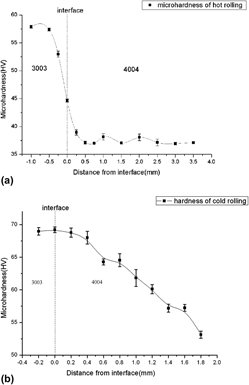Article contents
The microstructure and properties evolution of Al–Si/Al–Mn clad sheet during plastic deformation
Published online by Cambridge University Press: 03 June 2013
Abstract

The microstructure evolution and diffusion of silicon during heat-treatment and plastic deformation process were studied on the clad plates of Al–Mn/Al–Si aluminum composite fabricated by continuous casting. The results show that when the clad slab is homogenized and hot rolled, silicon diffuses across the interface from the Al–Si alloy (4004) side to the Al–Mn alloy (3003) side and dissolves into the 3003 matrix forming a solid solution. However, after deformation by cold-rolling, the increased driving force for precipitation of the solute elements in the core alloy side along with the abundant defects introduced by the severe deformation promotes the precipitation. Some Mg2Si particles precipitate from the solid solutions to form a transition region close to the interface of the two components. The presented transition area not only benefits the microstructure of the clad sheet but also improves the distribution of the microhardness across the interface, a tendency of gradient transition.
- Type
- Articles
- Information
- Copyright
- Copyright © Materials Research Society 2013
References
REFERENCES
- 10
- Cited by




